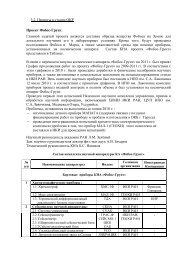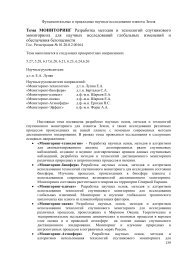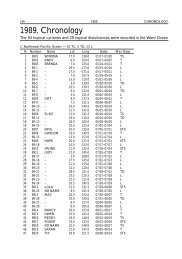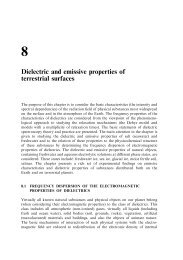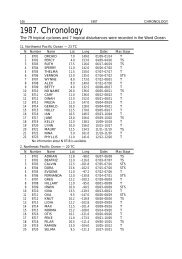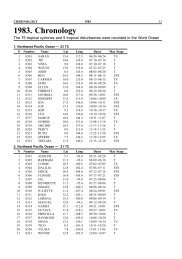ТРУДЫ МЕЖДУНАРОДНОЙ КОНФЕРЕНЦИИ - ИКИ РАН
ТРУДЫ МЕЖДУНАРОДНОЙ КОНФЕРЕНЦИИ - ИКИ РАН
ТРУДЫ МЕЖДУНАРОДНОЙ КОНФЕРЕНЦИИ - ИКИ РАН
Create successful ePaper yourself
Turn your PDF publications into a flip-book with our unique Google optimized e-Paper software.
V. N. Ishkov Solar Geoeffective Phenomena: Action on the Environment Space and the Possibility of the Forecast<br />
1970 is determined the X-ray class of solar flares, repeatedly changed the threshold<br />
of the maximum measured intensity of the soft X-ray in the range of energies<br />
(1…12.5 keV = 1…8 Å). Until 1976 the threshold of the photometer saturation corresponded<br />
to the X-ray class X5.4 and therefore famous solar flares August 4 and 7,<br />
1972 had formal class X > 5.4. Prior to the beginning of geostationary satellite GOES<br />
9 work threshold corresponded to the X-ray class X12.5, and afterward, in solar cycle<br />
23, threshold grew to X17.5. Accordingly, for most powerful flares, whose rate of occurrence<br />
exceeded the threshold indicated, X-ray class was determined conditionally:<br />
it is proportional to the time of the instrument cutoff. Therefore more objectively<br />
to characterize the X-ray class of such flares with saturation not only threshold<br />
value of the instrument saturation, but also duration of the time interval of the<br />
instrument cutoff (τ). By this it is explained, that the flare index, which is calculated<br />
from the X-ray class X (flux of the soft X-ray radiation >10 –4 W/m 2 ) and M<br />
(≥10 –5 …86.5 +2<br />
2 2.10.2003 10486 S17 354 2610 R5/S5/G5 >62.56 +3.5<br />
3 12.03.1989 5395 N34 257 3600 R5/S4/G5 57.0 –0.5<br />
4* 16.12.1982 4025+26 S06–S09 L089–L77 640 R5/S/G2 >36.56 +3.3<br />
5 13.03.1991 6555 S23 188 2530 R4/S5/G5 32.6 +1.5<br />
6 14.07.1982 3804 N14 L322 500 R5/S/G5 >28.73<br />
7 10.04.2001 9415 S22 359 880 R4/S3/G5 28.73 +1<br />
8 15.07.1978 1203 N18 L169 470 R5/S/G1 >27.09<br />
9 08.08.1989 5629 S17 076 1320 R5/S4/G3 ≥26.8 –0.5<br />
10 28.03.2001 9393 N20 152 2440 R5/S2/G5 >25.74 +1<br />
11 17.05.1990 6063 N34 321 940 R4/S3/G2 23.1 +1<br />
12 12.01.1989 5312 S31 308 1800 R3/S1/G2 22.4 –0.5<br />
13 15.01.2005 10720 N09 177 1630 R4/S3/G4 21.5 +4.7<br />
14 11.12.2006 10930 S06 009 680 R4/S2/G4 20.8 +6.6<br />
XX 04.08.1972 0331 N12 010 1330 R5/S5/G5 >26.0 +3.5<br />
An illustration said above it is Figure 2, which presents the emergence of new<br />
magnetic flux in December 2006 active region. New magnetic flux appeared at the<br />
end of day on December 11 directly near the small sunspot of positive magnetic polarity.<br />
In the magnetic field (2 and 4 columns) rapid changes are visible and small sunspot<br />
first doubles, changes its form and further it is decomposed into several fragments.<br />
Entire process engaged the approximately 48 hours, for which in the sunspot<br />
51



